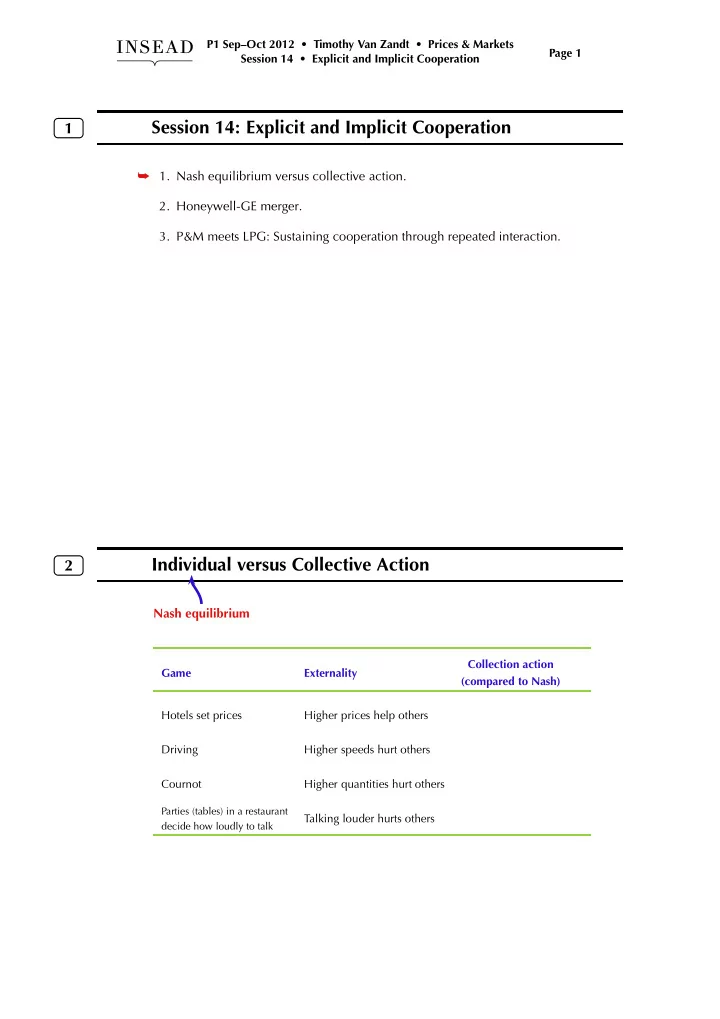

P1 Sep–Oct 2012 • Timothy Van Zandt • Prices & Markets Page 1 Session 14 • Explicit and Implicit Cooperation Session 14: Explicit and Implicit Cooperation 1 1. Nash equilibrium versus collective action. ➥ 2. Honeywell-GE merger. 3. P&M meets LPG: Sustaining cooperation through repeated interaction. Individual versus Collective Action 2 Nash equilibrium Collection action Game Externality (compared to Nash) Higher prices Hotels set prices Higher prices help others Low speeds Driving Higher speeds hurt others Lower quantities Cournot Higher quantities hurt others Parties (tables) in a restaurant Talk less loudly Talking louder hurts others decide how loudly to talk
P1 Sep–Oct 2012 • Timothy Van Zandt • Prices & Markets Page 2 Session 14 • Explicit and Implicit Cooperation Complementors game 3 If firms “collude”, do they raise or lower prices? Complementors game 4 What is the cooperative outcome?
P1 Sep–Oct 2012 • Timothy Van Zandt • Prices & Markets Page 3 Session 14 • Explicit and Implicit Cooperation Complementors game: Nash equilibrium 5 Ways to improve upon Nash 6 1. External enforcement: Sign contracts, pass laws, merge two firms. 2. Tacit, self-enforcing cooperation: through repeated interaction.
P1 Sep–Oct 2012 • Timothy Van Zandt • Prices & Markets Page 4 Session 14 • Explicit and Implicit Cooperation Session 14: Explicit and Implicit Cooperation 7 1. Nash equilibrium versus collective action. ✓ ➥ 2. Honeywell-GE merger. 3. P&M meets LPG: Sustaining cooperation through repeated interaction. Session 14: Explicit and Implicit Cooperation 8 ✓ 1. Nash equilibrium versus collective action. ✓ 2. Honeywell-GE merger. ➥ 3. P&M meets LPG: Sustaining cooperation through repeated interaction.
P1 Sep–Oct 2012 • Timothy Van Zandt • Prices & Markets Page 5 Session 14 • Explicit and Implicit Cooperation Repeated Prisoner’s Dilemma 9 Suppose the stage game is the following “Prisoner’s Dilemma”. Akbar and Jeff own competing gas stations, and can choose either to price high or to price low. Akbar P-low P-high 300 150 P-low 300 850 Jeff 850 700 P-high 150 700 Strategy: A plan of what to do at each time (e.g., each day) based on the history of play so far. Suppose game is repeated forever 10 Which of these are equilibrium strategies? 1. “Price low no matter what has happened so far”. 2. “Price high until Jeff prices low. Then price low forever, no matter what happens.”
P1 Sep–Oct 2012 • Timothy Van Zandt • Prices & Markets Page 6 Session 14 • Explicit and Implicit Cooperation When is Grim Trigger an equilibrium in this example? 11 1 What are the outcomes if Jeff sticks to the strategy? HH , HH , HH , . . . 700 700 700 2 PDV of flow of payoffs? 700 + 700 r 3 What are the outcomes if Jeff defects in period 1? LH , LL , LL , . . . 850 300 300 4 PDV of flow of payoffs? 850 + 300 r 5 When is it better for Jeff to stick to the strategy? 700 + 700 ≥ 850 + 300 ⇒ 400 / r ≥ 150 ⇐ ⇒ r ≥ 400 / 150 = 267% ⇐ r r Wrap up on repeated games 12 If a static game is repeated: • there is room for players to make credible threats and promises that support cooperation. • cooperation is not assured, but give it a try if the gain from cooperation is high.
P1 Sep–Oct 2012 • Timothy Van Zandt • Prices & Markets Page 7 Session 14 • Explicit and Implicit Cooperation Session 14: Explicit and Implicit Cooperation 13 1. Nash equilibrium versus collective action. ✓ ✓ 2. Honeywell-GE merger. ➥ 3. P&M meets LPG: Sustaining cooperation through repeated interaction.
Recommend
More recommend